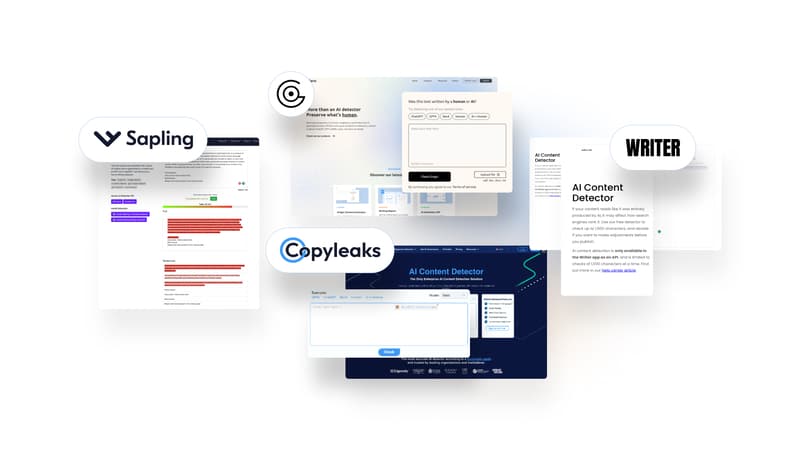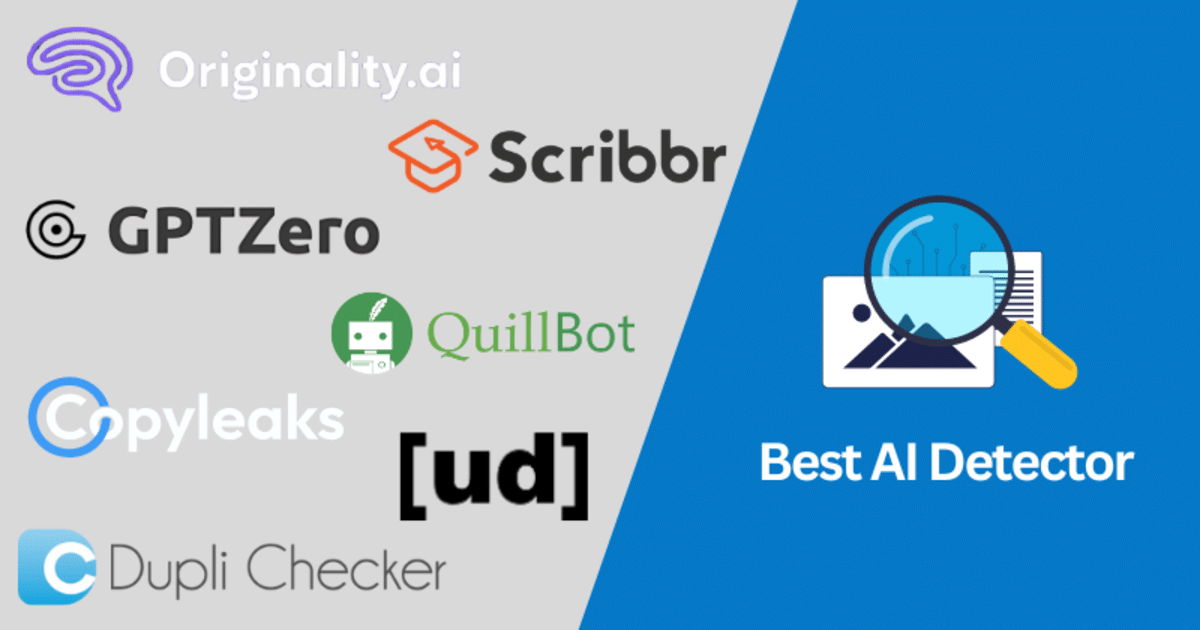Want to know more about free AI Text Detectors? This tutorial analyses the greatest tools, such as GPTZero, Winston AI, and others, to help you pick the one that is the most accurate, fast, and dependable.
Let’s be honest: writing made by AI is everywhere now. The distinction between writing by people and writing by machines has become less clear, from student essays to SEO blog entries. As AI tools get better, so grows the need for AI text detectors that work. There are a lot of free tools out there, but how do you know which one really works?
We’ll look at the best AI text detectors, compare their features, and talk about how they might be used in the real world in this article. This in-depth evaluation will help you select the proper tool, whether you’re a teacher, an editor, or just interested.

What are AI text detectors, and why do we need them?
AI text detectors are technologies that can discern if a piece of writing was made by a person or by a computer. These technologies look at text in many ways, like looking for statistical trends, analysing language, and using machine learning algorithms to figure out where it came from.
There is an increasing need for these tools. This is why:
- Academic honesty: Teachers need to be able to tell if pupils are turning in work that is their own.
- Quality of content: Editors want to make sure that articles are written by actual people.
- Ethical transparency: Publishers want to make it clear whose content was made by AI.
Trust dies when detection isn’t reliable. That’s why AI text detectors are more than just technological tools; they protect credibility.
A Comparison of the Best Free AI Text Detectors
Let’s look at the most popular free tools on the market and see how easy they are to use, how accurate they are, how they look, and what other features they have.
- GPTZero: A Quick Look GPTZero is one of the most well-known AI detectors. A college student invented it, and schools rapidly started using it.
Pros:
- Easy-to-understand scores (perplexity, burstiness)
- Made for learning
- No need to join up for quick checks
- In free mode, you can only use a limited number of words.
- Paraphrased content isn’t always correct. Best for teachers and students who need to quickly review brief messages.
- Winston AI Overview: Winston AI is a powerful tool that publishers and academics can employ. It looks at how easy it is to read the material and how likely it is that the author wrote it.
Pros:
- Very accurate
- Lets you upload PDF and DOCX files
- Keeps track of document history
Cons:
- The free plan only lets you do a few checks.
- You have to pay to have full functionality.
Best For: Teachers and professionals that need reports with a lot of information.
- Copyleaks AI Content Detector Overview: Copyleaks is recognised for finding copied content, but its AI content detection capability has become more popular.
Pros:
- Quick and easy to use
- Can be integrated with APIs
- Can be used as a Chrome extension
Cons:
- It can be hard to learn at first
- You can only use it for free for a short time
Best for: People who work in tech and businesses that need to keep track of a lot of stuff.
- ZeroGPT Overview: A basic, minimalist design makes this free AI text detector quite popular.
Pros:
- Free
- Quick results
- No need to log in
Cons: Sometimes gives false positives
- Doesn’t always explain why the results are what they are
Best For: People who don’t use it often and want a quick answer.
- Content at Scale Detector Overview: This tool is made just for SEO writers and agencies and is meant for long-form content.
Pros:
- Focus on natural language
- Great for bloggers
- Feedback right away
- Not great for short text
- May have trouble with mixed content (human and AI)
Best For: SEO experts who are looking at drafts of blogs and website material.

How AI Text Detectors Work Behind the Scenes
Even while each tool has its unique algorithm, most detectors look at the same basic things:
- Confusion
This tells you how hard it is to guess what a sentence means. Writing by people is usually more varied and less predictable than writing by AI.
- Burstiness
This looks at how the length of sentences can change. A person might write a brief, to-the-point sentence followed by a long, rambling idea. AI is more consistent.
- The chance of a word
“Token prediction” is what AI algorithms employ. If a statement has a lot of words that are very easy to guess, it is more likely to have been made by a computer.
These systems are smart, but they’re not perfect. This is especially true when the content is a mix of AI-assisted writing and human editing.
What Free AI Text Detectors Can’t Do
It’s crucial to recognise that these tools aren’t perfect before you trust them too much:
- False positives: If a piece of writing is excessively polished or doesn’t have any emotion, it could be labelled as AI.
- False negatives: If AI-generated content is modified or ingeniously encouraged, it can get through without being noticed.
- Language problems: Most tools work well in English and may not correctly find AI in other languages.
Even the finest AI text detectors can’t be sure. They give you chances, not proof.
How AI Text Detectors Can Be Used in the Real World
Let’s talk about some common circumstances where these tools are useful.
- In the Classroom
A high school teacher gets an essay that sounds like it was prepared by a PhD. The student’s writing in class says differently. Using GPTZero or Winston AI can help start a conversation, not punish someone.
- In Marketing Content
A freelance writer sends SEO content to an agency. Something’s not right; all the pieces sound the same. If you run the text via Copyleaks, you’ll see that most of the submissions were probably authored by AI.
- In the news
A newspaper wants to make sure that columnists write content and not tools. Editors employ Winston AI every week to keep things honest.
These examples indicate that AI text detectors are more than simply tools for spying; they help us figure out who wrote something and keep it real.

How to Use AI Text Detectors in a Responsible Way
You should always use good judgement with even the most accurate tool. This is how to use them wisely:
- Don’t just look at the scores: Use the tool to get a first impression, not to make a final choice.
- Always read the writing: You can’t always give points for tone, organisation, and personal thought.
- Speak with the author: A casual conversation with a student or coworker can frequently tell you more than an algorithm.
Tools give us information, but humans make the choices.
How to Pick the Best Free AI Text Detector for You
There is no one solution to the question, “Which AI text detector is best?” It all depends on what you need:
Use Case Best Detector Why quick checks in the classroom GPTZero Easy and free Academic honesty Winston AI Detailed reports
Review of SEO content Content at a Large Scale Made for composing extended pieces
Casual checking ZeroGPT Light and quick Professional publishing Copyleaks Accurate and able to grow
Try out a few and see which one works best for you. If you use these tools often, you might want to think about getting a subscription plan that gives you more capabilities.
What Will Happen to AI Text Detectors
Detection systems will get better as AI writing tools do. Some new trends are:
- Watermarking AI content: Developers can put hidden signals into text that they make.
- Tracking the writing process: Soon, tools may be able to record how a document is made, including drafts, changes, and time spent.
- Hybrid detection models: Future detectors might use a mix of metadata, behaviour, and writing style.
We have to understand that there may never be perfect detection. That’s OK. The actual goal isn’t to capture AI; it’s to figure out how we’re employing it.
Be careful and clear when using AI text detectors. AI isn’t going anywhere. The worry about what it means for writing, learning, and truth is also not going away. AI text detectors are important not because they solve the problem, but because they let us ask better questions.
We shouldn’t be afraid of AI as consumers, readers, and teachers. Instead, we should utilise it properly and tell others to do the same. Detection tools that are free aren’t always right. But if you use them carefully, they can raise awareness, safeguard integrity, and remind us that every statement should have a human voice behind it.
To stay updated on the latest AI developments and tool reviews, follow us on our social media channels:
- Blog: https://aitoolsbiz.com/my-blog
- YouTube: https://youtube.com/@AItoolsbiz
- Twitter: https://x.com/AItoolsbiz
- LinkedIn: https://www.linkedin.com/in/aitoolsbiz







